
Functional Composites and Structures
Scope & Guideline
Driving Innovation in Composite Applications.
Introduction
Aims and Scopes
- Composite Material Development:
Research on the creation and enhancement of composite materials, including carbon, graphene, and natural fibers, focusing on improving mechanical, thermal, and electrical properties. - Advanced Manufacturing Techniques:
Exploration of novel manufacturing processes such as additive manufacturing and 3D printing that enable the production of complex composite structures with tailored properties. - Performance Evaluation and Testing:
In-depth studies on the mechanical, thermal, and electrochemical performance of composites under various conditions to assess their suitability for specific applications. - Functional Applications:
Research on the application of composites in various sectors including aerospace, biomedical engineering, and energy harvesting, emphasizing their multifunctional capabilities. - Modeling and Simulation:
Utilization of computational methods and finite element analysis to predict the behavior of composites under different loading conditions and to optimize their design.
Trending and Emerging
- Nanocomposite Materials:
There is a growing emphasis on the development and application of nanocomposites, particularly those incorporating carbon nanotubes and graphene, which enhance the mechanical and electrical properties of traditional composites. - Self-Healing and Smart Materials:
Research on self-healing composites and smart materials that can respond to environmental stimuli is trending, highlighting the demand for materials that enhance durability and functionality. - Sustainable and Eco-Friendly Composites:
An emerging focus on bio-based and sustainable composite materials is evident, driven by environmental concerns and the need for greener alternatives in material design. - Energy Harvesting Systems:
The integration of composite materials in energy harvesting applications, such as triboelectric nanogenerators and hybrid capacitors, is gaining traction, reflecting a broader interest in renewable energy solutions. - Advanced Characterization Techniques:
There is an increasing trend toward utilizing advanced characterization techniques, including molecular dynamics and finite element analysis, to gain deeper insights into the behavior and performance of composites.
Declining or Waning
- Traditional Fiber Reinforcement Techniques:
There has been a noticeable decline in research focused solely on conventional fiber reinforcement methods, as the field shifts towards more innovative and hybrid approaches involving advanced materials. - Basic Mechanical Testing:
Research that primarily emphasizes basic mechanical testing without integration of advanced modeling or application-oriented studies appears to be waning, as the journal favors comprehensive analyses that include predictive modeling. - Single-Function Composites:
The trend is moving away from composites designed for a single function, as there is increasing interest in multifunctional composites that can serve various applications simultaneously. - Conventional Manufacturing Processes:
Research centered on traditional manufacturing processes is becoming less prominent, as the focus shifts towards cutting-edge techniques such as additive manufacturing and hybrid fabrication methods.
Similar Journals
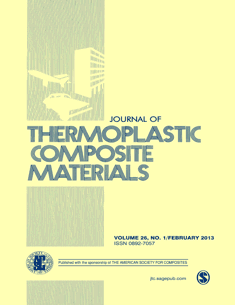
JOURNAL OF THERMOPLASTIC COMPOSITE MATERIALS
Exploring Breakthroughs in Thermoplastic ApplicationsJOURNAL OF THERMOPLASTIC COMPOSITE MATERIALS, published by SAGE PUBLICATIONS LTD, is a cutting-edge journal dedicated to advancing the field of thermoplastic composites and their applications within ceramics and condensed matter physics. With an ISSN of 0892-7057 and an E-ISSN of 1530-7980, the journal boasts a strong academic reputation evidenced by its impressive impact factor as well as its classification in the 2023 Q2 category for both Ceramics and Composites and Condensed Matter Physics. Ranked #60 in Condensed Matter Physics and #26 in Materials Science by Scopus, the journal plays a pivotal role in disseminating innovative research findings, trends, and advancements to a global audience. Spanning research from 1988 to 2024, it serves as an essential resource for researchers, professionals, and students alike, fostering collaboration and promoting knowledge in the ever-evolving landscape of thermoplastic composite materials. Although currently not open access, the comprehensive content and critical insights provided by this journal are invaluable for those engaged in cutting-edge research and practical applications in these fields.

Composites Research
Elevating Knowledge in the World of CompositesComposites Research is an esteemed academic journal dedicated to advancing the field of composite materials, published by the Korean Society of Composite Materials. With a focus on innovative research and development, this journal serves as a vital platform for researchers, professionals, and scholars in the field, promoting high-quality papers that discuss both theoretical and practical aspects of composite materials. Although it operates under a traditional access model, the journal remains committed to disseminating essential knowledge and cutting-edge findings relevant to the latest trends and technological advancements in composites. The ISSN 2288-2103 and E-ISSN 2288-2111 ensure the widespread visibility and accessibility of published works. The journal is strategically positioned to contribute to the growing body of knowledge in composite research, enabling the exchange of ideas and collaboration among a global audience.

Journal of Polymer & Composites
Unveiling Breakthroughs in Material Science and Engineering.Journal of Polymer & Composites, with ISSN 2321-8525 and E-ISSN 2321-2810, is an esteemed academic journal published by STM JOURNALS, dedicated to the advancement of knowledge in the rapidly evolving fields of polymer science and composite materials. The journal serves as a pivotal platform for researchers and professionals, offering cutting-edge research articles, reviews, and case studies that explore innovative developments and applications in polymer chemistry, material science, and engineering. Although currently lacking an impact factor citation, the journal aims to foster dialogue among academia and industry partners, addressing the latest trends and breakthroughs that drive the field forward. With a commitment to scholarly excellence, the Journal of Polymer & Composites is positioned as an essential resource for enhancing the understanding of polymer composites and their multifaceted applications. Notably, STM JOURNALS' reputation for quality publications underscores the journal’s importance in facilitating impactful research and educational initiatives worldwide.

MATERIALE PLASTICE
Elevating the Study of Chemistry and EngineeringMATERIALE PLASTICE is a distinguished academic journal published by REVISTA CHIMIE SRL in Romania, focusing on the fields of Chemistry, Materials Science, and Engineering. With an ISSN of 0025-5289 and an E-ISSN of 2668-8220, this journal has a historical commitment to advancing the study of polymers and plastics since its inception in the early 1970s. Although classified in the Q4 category across multiple disciplines including miscellaneous chemistry and materials chemistry as of 2023, it serves as an important forum for researchers and professionals dedicated to innovative materials research and development. The journal’s resources, though not openly accessible, are pivotal for scholars seeking to deepen their knowledge in the mechanics of materials and interdisciplinary applications. MATERIALE PLASTICE is not only a repository of significant research findings but also a platform for fostering collaboration and discussion among a global audience that continues to strive for scientific excellence in polymer and materials studies.
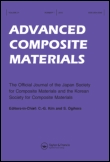
ADVANCED COMPOSITE MATERIALS
Pioneering the Next Generation of CompositesADVANCED COMPOSITE MATERIALS, published by Taylor & Francis Ltd, is a leading peer-reviewed journal in the field of materials science, specifically focusing on the innovative development and applications of composite materials. With an ISSN of 0924-3046 and E-ISSN 1568-5519, this journal serves as a vital resource for researchers and professionals worldwide, examining cutting-edge advancements and methodologies in composites, ceramics, and mechanical engineering. Having secured a solid standing in the academic community, it boasts impressive Scopus rankings, such as #185 in Mechanical Engineering with a 72nd percentile and #46 in Ceramics and Composites, emphasizing its relevance and rigor. Although not an open-access publication, its insights are invaluable for those looking to explore, contribute to, and stay abreast of the latest breakthroughs in the field from 1991 through 2024. By targeting critical areas within mechanics and material sciences, the journal continues to foster innovation and scholarly discussion, making it an essential venue for specialists striving to advance the capabilities and applications of composite materials.
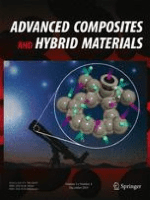
Advanced Composites and Hybrid Materials
Innovating the Future of Materials ScienceAdvanced Composites and Hybrid Materials, published by SPRINGER NATURE, is a premier journal dedicated to the field of materials science, with a keen focus on innovative composite materials and their applications. With its ISSN 2522-0128 and E-ISSN 2522-0136, the journal has established itself as a cornerstone for researchers and professionals in materials chemistry, ceramics, and polymers, achieving an impressive Q1 ranking across multiple categories in 2023. In particular, it ranks #3 out of 161 in Polymers and Plastics and #4 out of 127 in Ceramics and Composites, highlighting its influential presence within the academic community. The journal aims to provide a cutting-edge platform for the dissemination of groundbreaking research and developments from 2018 to 2024, facilitating knowledge sharing and collaboration among experts. While currently adopting a traditional access model, the significance and impact of research published in this journal cannot be overstated, making it an essential resource for anyone interested in advancing the field of composite materials.

Journal of Composites Science
Transforming Engineering with Cutting-edge Composites InsightsThe Journal of Composites Science, published by MDPI, is a premier Open Access journal dedicated to advancing the field of composites and materials science. Launched in 2017, this innovative journal provides a platform for researchers, professionals, and students to share findings, methodologies, and insights related to composites, ceramics, and engineering applications. With an impressive Q2 ranking in both the Ceramics and Composites and Engineering (miscellaneous) categories for 2023, the journal is well-positioned within the academic community, ranking 48th out of 204 in miscellaneous engineering and 47th out of 127 in ceramics and composites according to Scopus. The journal's open-access model ensures that high-quality research is widely available to the scientific community, fostering collaboration and innovation. Situated in defensive Switzerland at ST ALBAN-ANLAGE 66, CH-4052 BASEL, the Journal of Composites Science is an essential resource for those seeking to stay at the forefront of the composites domain and drive progress in engineering practices.
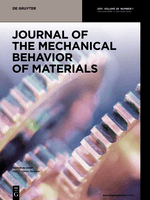
JOURNAL OF THE MECHANICAL BEHAVIOR OF MATERIALS
Innovating the Future of Materials ScienceJOURNAL OF THE MECHANICAL BEHAVIOR OF MATERIALS, published by DE GRUYTER POLAND SP Z O O, is a prominent open-access journal in the field of materials science and mechanics, dedicated to facilitating the dissemination of high-quality research findings since 2019. With an ISSN of 0334-8938 and an E-ISSN of 2191-0243, this journal provides a platform for researchers, professionals, and students to explore the mechanical behaviors of various materials, crucial for advancing engineering and scientific applications. The journal's impact is evidenced by its impressive rankings, including Q2 status in both Materials Science (miscellaneous) and Mechanics of Materials as of 2023. With a Scopus rank placing it in the top-half of indexed journals, the JOURNAL OF THE MECHANICAL BEHAVIOR OF MATERIALS is a vital resource for anyone looking to stay at the forefront of material behavior research. Based in Germany, it serves the global academic community while catering to the evolving needs of industry practitioners through its comprehensive open-access model.

AIMS Materials Science
Empowering Research in Materials ScienceAIMS Materials Science is an esteemed open-access journal dedicated to advancing the field of materials science. Published by the American Institute of Mathematical Sciences (AIMS), this journal has been a vital resource for researchers, professionals, and students since its inception in 2014. With an ISSN of 2372-0468 and an E-ISSN of 2372-0484, it focuses on disseminating high-quality research in materials science, ranging from general materials science to cutting-edge advancements in innovative materials applications. Currently ranked Q3 in the 2023 Scopus Materials Science (miscellaneous) category, with a ranking of 253/463, AIMS Materials Science strives to provide an open forum for scholarly dialogue and collaboration, ensuring valuable insights are accessible to the global scientific community. The journal's commitment to open access enhances its visibility and reach, further promoting impactful research in this dynamic field.
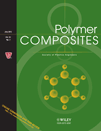
POLYMER COMPOSITES
Exploring Innovations in Composite MaterialsPOLYMER COMPOSITES, published by WILEY, is a leading journal dedicated to advancing the fields of materials science and engineering through the exploration of polymer composite materials. With its foundation dating back to 1980, this esteemed journal has continuously provided a platform for researchers to publish high-quality studies and innovative methodologies in areas such as ceramics, composites, and miscellaneous chemistry. Ranked in the prestigious Q1 quartile for sectors like Polymers and Plastics as well as Materials Chemistry, POLYMER COMPOSITES stands significant within the academic community, holding a notable impact factor that reflects its influence. The journal encompasses a comprehensive range of topics, making it essential reading for professionals, researchers, and students aiming to stay at the forefront of developments in polymer science and composite technologies. Although it does not currently offer Open Access, readers can access its impactful publications through institutional or individual subscriptions, contributing to ongoing advancements in the field and facilitating the exchange of valuable knowledge among scientists and engineers worldwide.